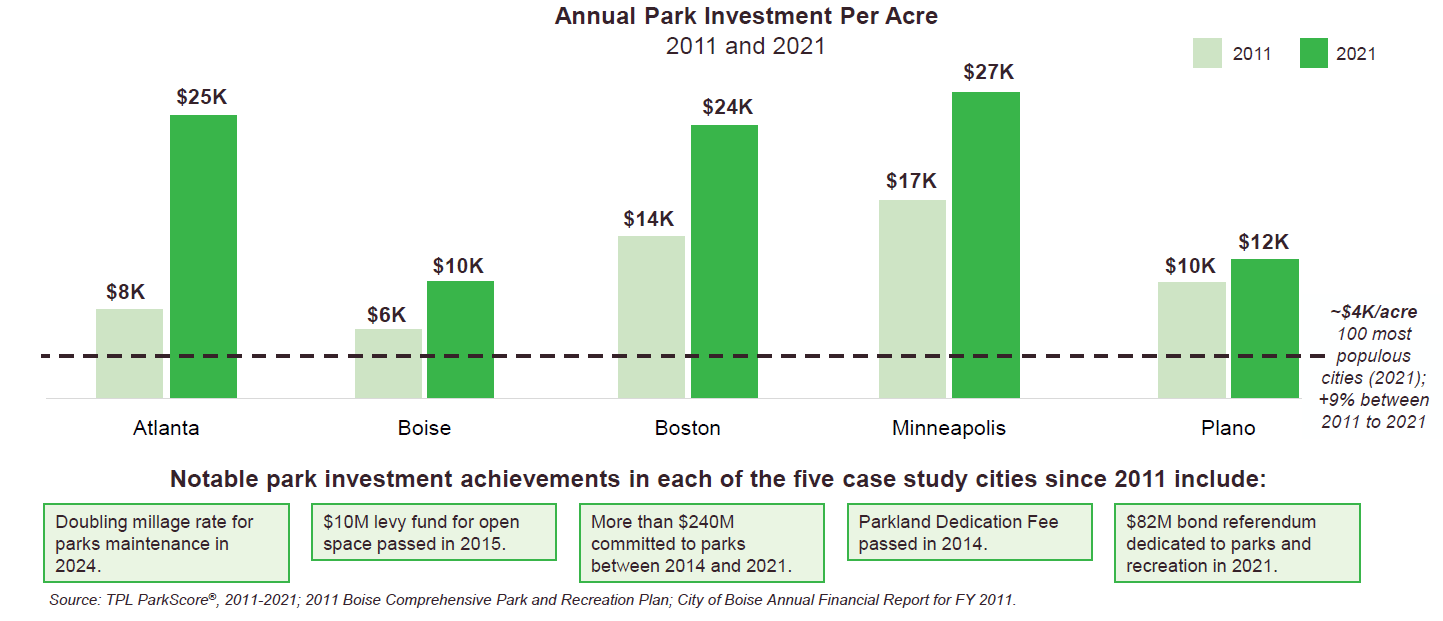Executive Summary
This study shows that civic and business leaders are increasingly prioritizing investment in green spaces to bolster economic vitality. City leaders are seeking opportunities to grow their tax base and retain and attract more businesses and residents. In the post-pandemic era when employers offer geographic mobility, it is more important than ever that cities invest in place, specifically parks and open spaces, to attract and retain a diverse workforce.
Parks are powerful engines for economic development. Local public park and recreation agencies in the United States generate more than $201 billion in economic activity and support almost 1.1 million jobs that boosted labor income by more than $63 billion from their operations and capital spending in 2021.1 Parks contribute to population growth and economic vitality by boosting quality of life and making cities more attractive places to live and work. Investing in parks to close gaps toward equitable access to parks is vital to a city’s attractiveness among peer cities competing for residents and businesses.
Trust for Public Land (TPL), as part of the organization’s focus on advancing park equity to ensure healthy, livable communities, engaged HR&A Advisors to research how community investment in parks, open spaces, and associated quality-of-life benefits contribute toward achieving economic development goals in cities in the U.S. This report dives into five case study cities—Atlanta, Georgia; Boise, Idaho; Boston, Massachusetts; Minneapolis, Minnesota; and Plano, Texas—to show how cities can leverage investments in parks to catalyze economic growth, drive greater economic mobility, and create wealth-building opportunities for communities.
The five case study cities studied in this report were selected based on their park investment and economic vitality indicators that exceed other cities. TPL and HR&A Advisors sought diversity in location, size, and economic drivers among the five case study cities. Researchers conducted interviews with a range of businesses and civic leaders in each selected city to better understand the motives and relationships driving these positive trends in park investment and economic vitality. The study showcases a strong correlation between park investment and economic vitality, recognizing a range of attributes contribute to a city’s economic health.
Findings
Case Study Cities

-
Boise leverages its iconic, natural open spaces and growing parkland to attract talent, businesses, and new development to the city.
Young talent and families are attracted to Boise for its expansive natural open spaces, economic mobility, walkable downtown, and affordability, which remains compelling despite recent rises in housing costs. As Boise experiences rapid economic and population growth, civic leaders are investing more in the city’s urban park features to support the growing population. Property owners and developers—individually or in partnership with the City and other civic organizations—have built a more urban, walkable, mixed-use downtown featuring neighborhood parks, dog parks, and pocket parks. They are investing directly in the development and activation of parks and open spaces to serve not only commercial tenants but also the larger neighborhood.
U.S. cities with growing economies, regardless of size or location, are investing more in parks and open spaces.

Cities investing in parks and open spaces attract and retain high-skilled workforce at the highest rates in the nation.

Implications
As central business districts struggle to stabilize, and as work becomes increasingly flexible and mobile, park system investment and stewardship are critical tools for cities to remain attractive and to grow healthy economies. This study explores five case study cities that are investing in parks and open spaces and simultaneously experiencing economic growth. Bolstered by vibrant parks and open spaces, these cities provide a thriving quality of life that attracts and retains a diverse workforce.
Civic leaders, real estate developers, and companies must invest in parks and open spaces to enjoy the range of benefits—economic vitality, community benefits, and fiscal health—that parks provide.
Cities can employ a range of tools to grow park investment and engage business leaders, including initiatives to shepherd philanthropy and sponsorship, value capture mechanisms, and development exactions and regulations. Each of these tools is an opportunity for private firms to support park departments and champions either through advocacy or direct contributions. In return, cities enjoy growing residential populations, workforces, and visitation; sustained attraction and retention of businesses, continued real estate development; and increased foot traffic and activation in the public spaces.

